Shopify and Etsy are two of the biggest names in the ecommerce world- attracting millions of sellers worldwide. So, which is the right platform for you? After experimenting with both platforms extensively over the years, I can safely say that Shopify is the better option overall.
While Etsy is a great marketplace for hobbyists selling handmade goods and niche items, it really can’t compare with Shopify in terms of scalability, innovative sales and marketing tools, and overall performance. Plus – the gap between the two platforms is growing.
Etsy sellers are leaving the platform in droves in 2025, in search of a solution that gives them more scope to build a sustainable brand, and outshine the competition.
Still unsure? Here’s your behind-the-scenes guide to how Shopify and Etsy compare in 2025.
Quick Comparison: Shopify vs Etsy
Pressed for time? Here’s a quick overview of both platforms, and the biggest differences between them for online sellers.
| Comparison Criteria | Shopify | Etsy |
| Value for Money | Shopify is more expensive on the surface, with plans starting at $29 per month (paid annually), but the transaction fees are lower, and you get more features for your money. | Sellers can technically start selling for free on Etsy, but there are additional fees that can add up over time, like listing fees, transaction fees, and processing fees. |
| Templates and design tools | Shopify has more professional store and website design tools than Etsy – and gives you more freedom to build a memorable brand. | Etsy’s store designs are all pretty generic, making it harder for new sellers to stand out from the crowd. |
| Selling Features | Shopify has some of the best sales features of any ecommerce platform. It supports omnichannel sales, and has robust product and inventory management tools. | Etsy’s sales tools are pretty basic. You can sell products and digital downloads in a range of currencies, but there are no advanced solutions for business management. |
| Marketing Tools | Sellers can tap into Shopify tools for email marketing, instant chat, SEO and content creation, and even social media marketing. | Etsy gives sellers direct access to a large audience, but there aren’t a lot of dedicated marketing tools to explore. |
| Ease of Use | Shopify is extremely easy to set up and use, even for complete beginners. | Setting up a store with Etsy is extremely straightforward – even if you’re using advanced tools like Pattern for customization. |
| Customer Support | Shopify offers AI-powered live chat, 24/7 customer care, and a valuable selection of self-help resources. | Etsy offers some great self-help resources, but there aren’t a lot of ways to reach the company if you need more support. |
Shopify vs Etsy: My Quick Recommendations
- Shopify – Best for building your own branded store and scaling long-term
- Etsy – Best for selling handmade or vintage products with built-in marketplace traffic
Shopify vs Etsy: Which is Better Value for Money?
Let’s start by comparing pricing. A lot of new sellers choose Etsy over Shopify initially because they think it offers a cheaper way to build and run an online store. Technically, that’s true, as you can create an account with Etsy for free.
However, there are a bunch of “extra” fees on Etsy that can quickly add into your profits. For instance, you’ll have to pay a $0.20 listing fee for every product you want to add to your store (and that automatically renews each month).
Plus, there’s a 6.5% transaction fee charged on each order, and payment fees for every order (which vary based on the processer used).
If you want to access extra features on Etsy, there are even more costs to consider. Etsy Plus costs $10 per month (giving you extra budget for listings and personalized Etsy ads).
Etsy Pattern, which allows users to create a more “personalized” storefront costs $15 per month after your first month.
Notably, Etsy is still cheaper than Shopify, even with those costs. Shopify’s main plans range from $29 to $299 per month if you pay annually.
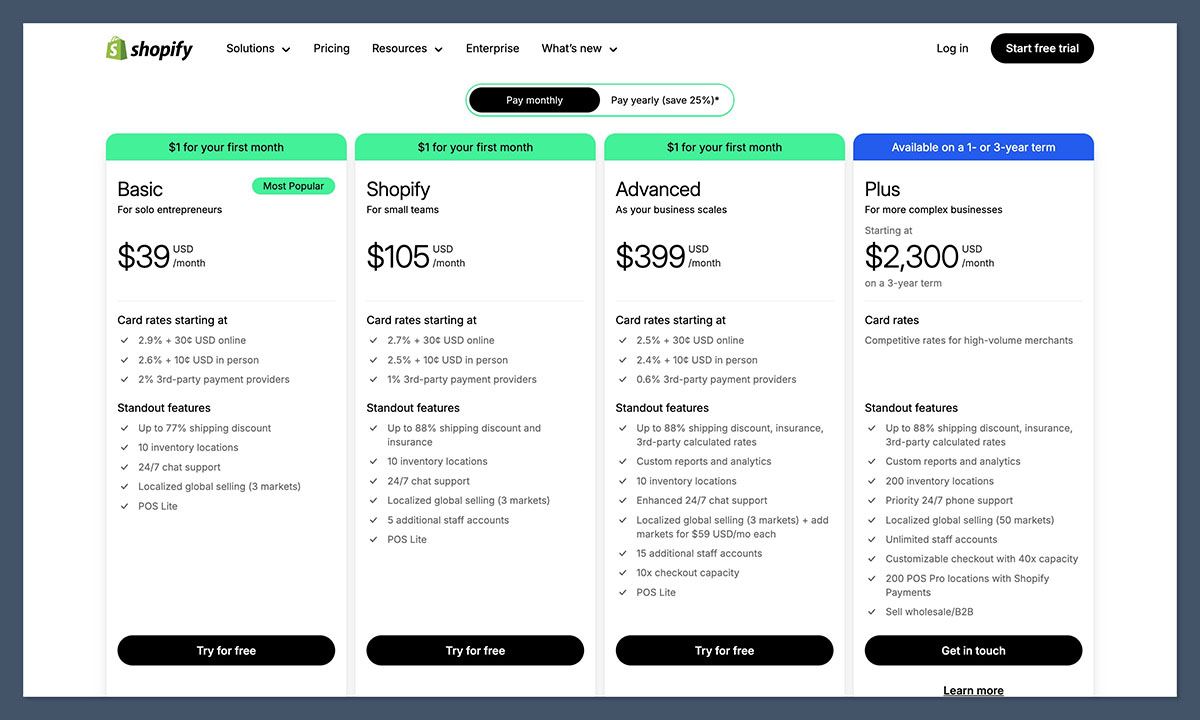
At the moment, Shopify have brought back their $1 deal, meaning that for just $1/month for the first 3 months, you can get access to Shopify’s ecommerce tools.
Although you can use Shopify Starter for just $5 per month – that doesn’t give you access to the full Shopify experience.
Plus, Shopify does charge transaction fees when companies use a third-party payment processor (anything other than Shopify Payments).
However, it’s worth remembering you get a lot more bang for your buck with Shopify.
Even the basic plan ($29 per month) includes analytical and reporting tools, shipping discounts, omnichannel selling features, and marketing tools – all things you miss out on if you choose Etsy instead.
Ultimately, Etsy might be cheaper, but Shopify gives you more value for your money.
Shopify vs Etsy: Which is Better for Print on Demand?
For Shopify vs Etsy, Shopify is the better choice for print on demand—no question. While Etsy is easier to start with, its high fees, limited branding, and marketplace restrictions make it hard to scale.
With Shopify, you own your store, keep more profits, and have full control over your marketing and customer relationships.
Plus, Shopify integrates with top print on demand suppliers, automates fulfillment, and gives you all the tools you need to grow. If you’re serious about building a long-term business, Shopify wins—hands down.
If you’re thinking about launching a print on demand business, picking the right platform is crucial. The last thing you want is to deal with limited branding options, high fees, or a platform that doesn’t give you full control over your business.
So, which is better—Shopify or Etsy? The answer is pretty clear.
Etsy is easier to start with, but Shopify is better for long-term success.
Here’s why:
1. Shopify Gives You More Control
With Shopify, you’re not just another seller on a crowded marketplace. You own your store, your branding, and your customer list. This means you can build a real business, instead of just competing in a race to the bottom on price.
On Etsy, your shop looks just like everyone else’s. You can’t customize your storefront beyond a few small tweaks, and you’re constantly fighting for attention in Etsy’s search results.
2. Etsy Has Higher Fees
Etsy might seem like the cheaper option at first, but those fees add up fast.
- $0.20 per listing (renewed every four months)
- 6.5% transaction fee on every sale
- Payment processing fees that vary by country
With Shopify, you pay a fixed monthly fee (starting at $29/month), but you keep more of your profits. And if you use Shopify Payments, you skip the extra transaction fees altogether.
3. Shopify Integrates with More Print on Demand Suppliers
One of Shopify’s biggest advantages is its huge app ecosystem. You can connect your store to top print on demand platforms like:
- Printful
- SPOD
- TeeLaunch
- AOP+
These services automate everything—from printing to shipping—so you don’t have to lift a finger.
Etsy does allow print on demand, but you’ll have to manually connect your shop to third-party suppliers like Printify. Plus, Etsy prefers handmade items, so you risk getting your store suspended if they think your business doesn’t fit their guidelines.
4. Shopify is Better for Scaling
Let’s be real—if you’re serious about growing a profitable print on demand business, Etsy will hold you back.
With Shopify, you can:
- Run Facebook and Google ads to bring in more customers
- Use email marketing to keep buyers coming back
- Create a blog to drive organic traffic
- Offer subscriptions, upsells, and discounts to boost revenue
Etsy? Not so much. You’re at the mercy of their algorithm and can’t do much to control your traffic or customer experience.
Website Design and Personalization Tools
If you want to design an online presence that really stands out – Shopify is obvious choice. Etsy isn’t really a “web design tool”.
It’s a marketplace platform that allows you to create a generic storefront and sell products alongside other retailers.
All Etsy stores follow the same basic template – so every store looks and feels almost exactly the same.
Paying the $15 per month subscription for Etsy Pattern will allow you to build more of a “unique” standalone online store. However, Pattern’s features are pretty basic too.
You still won’t get a huge range of templates and themes to choose from, and you’ll be missing access to a host of other features that Shopify offers (like SEO tools and native email marketing).
Shopify gives you far more comprehensive control over your “branding” and the experience customers get on your store.
There are 13 different free themes, and hundreds of paid themes you can use to alter the appearance of your store.
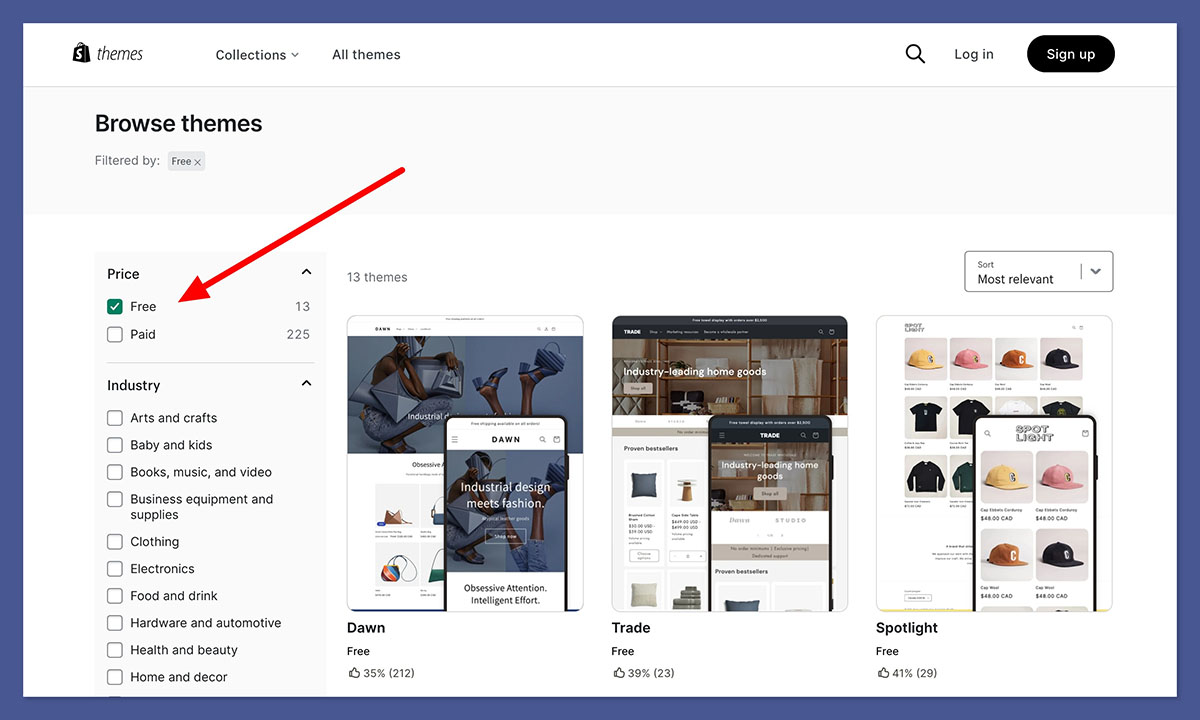
Plus, even without extensive developer knowledge, it’s relatively easy to tweak your Shopify theme to match your brand’s aesthetic and personality.
Shopify’s themes come with a range of ecommerce features already baked in too, like multi-currency and multi-lingual features, countdown timers, mega menus, and so on.
The biggest downside with Shopify’s design tools is that some elements of your store are tougher to customize than others (such as the checkout page for instance) – you might find yourself in need of some extra developer support.
Shopify vs Etsy: Selling Features
At this point, I’ve used and reviewed dozens of ecommerce platforms and marketplace tools, from BigCommerce, to Wix, Squarespace, and beyond.
Shopify is still my number one go-to platform for sales features – and it only gets better with every update.
Shopify gives you everything you need to run a comprehensive online store. With Shopify, you can sell hundreds of different types of products (whereas Etsy focuses mostly on hand-made goods).
You can even integrate your store with dropshipping or print on demand platforms, or use apps to sell services, digital downloads, and other goods.
Shopify also supports omnichannel selling, allowing you to sell items across social media platforms, and marketplaces (like Etsy and Amazon).
You can also take advantage of Shopify POS to sell products directly offline too. Plus, Shopify offers:
- Numerous payment methods: Shopify integrates with over 100 payment providers, and supports multicurrency selling for global companies.
- Shipping options: Shopify Shipping makes it easy to manage shipping strategies with carriers like USPS, UPS, FedEx, and DHL Express.
- Inventory and product management: Shopify’s extensive inventory and product management tools make it easy to track all aspects of your company’s operations.
Not to mention, there are thousands of free and paid apps available on the Shopify app marketplace that give you even more sales tools and features to experiment with.
In comparison, Etsy’s selling tools are extremely basic. You can list products, track orders and shipments, access order details, and create informative product pages.
You’ll also get access to search analytics, and tools for creating simple shipping labels. Plus, Etsy does support various currency options and payment methods. But overall, you get a much more simplistic experience.
Etsy doesn’t even have a built in POS solution – although it can integrate with other POS providers – like Shopify and Square.
Shopify vs Etsy: Marketing Tools
Again, if you’re looking for comprehensive marketing tools, Shopify is the clear winner. Since Etsy is primarily a global online marketplace, you don’t really get a lot of marketing features built-in.
The biggest benefit you get from the platform is that your products will instantly be visible to millions of Etsy visitors worldwide – but they’ll also be competing for attention with thousands of other products.
Most sellers need to devote a lot of time and effort to optimizing their store for Etsy’s algorithm and building comprehensive marketing campaigns.
On the plus side, you can create and share social posts with Etsy across channels like Facebook, Instagram, and Pinterest.
Still, you won’t get any email marketing tools, SEO solutions, or even a blog where you can attract customers to your site with strategic content marketing.
On the other hand, you’ll need to build your own customer base from scratch with Shopify – but the platform does give you plenty of tools to help with that.
Shopify is SEO-friendly, making it easy to boost your chances of ranking on the search engines for specific search terms.
It also comes with tools for blogging, a built-in email marketing solution (Shopify Email) and live chat tools.
You can also create forms with Shopify to capture customer contact details, or take advantage of a range of integrations with marketing apps, like MailChimp for email marketing, or PageFly for designing custom landing pages.
Shopify also supports a range of other features, like custom pop-ups, sales banners, social media product feeds and more.
Which is Easier to Use? Shopify or Etsy?
On a broad scale, I think Etsy and Shopify are about equally easy to use. They both make it really simple to get started, with “onboarding” steps for beginners that walk you through the process of building your storefront.
Etsy breaks the journey down into about six steps, while Shopify sends you to a personalized set up guide with specific tips based on the type of store you want to create.
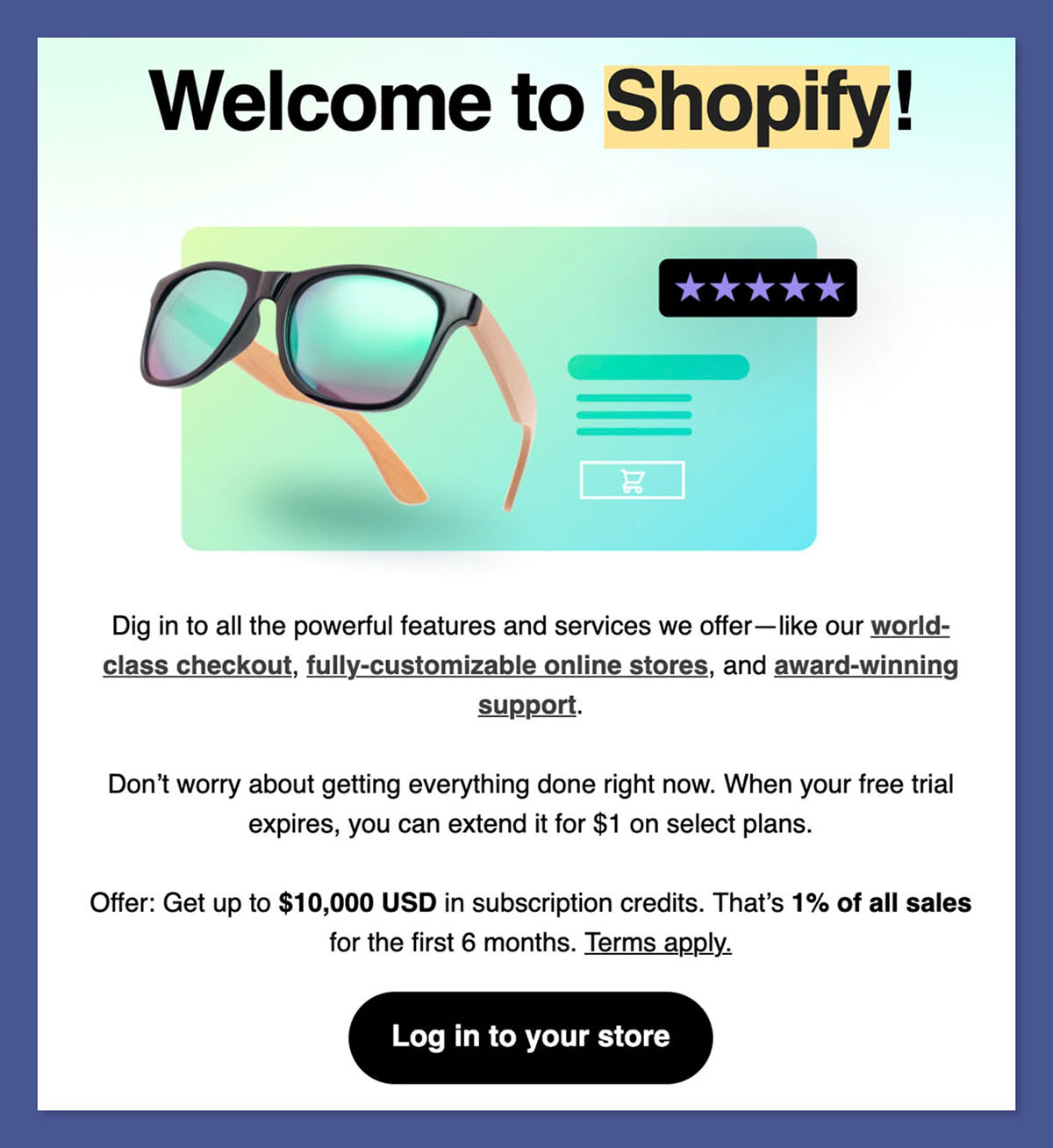
Notably, since Shopify does have more features than Etsy, it might take slightly longer to get your website fully configured.
However, Shopify has more advanced tools to help you complete certain tasks. For instance, the Shopify Magic AI tool can generate text for you, like product descriptions and headings in seconds.
Plus, there’s the Shopify Sidekick feature – an AI tool that can answer any questions you might have about ecommerce.
Another thing that Shopify makes very straightforward is connecting your store to other sales channels.
In fact, you can immediately connect your Shopify store to Etsy (as well as other social media channels). You can even import items to Shopify directly from your Etsy storefront.
Shopify vs Etsy: Customer Support
Finally, let’s consider customer support. Again, I think Shopify is the clear winner here. Shopify gives you a fantastic live chat feature (see screenshot below), so you can access instant answers to questions without waiting around, refreshing your inbox.
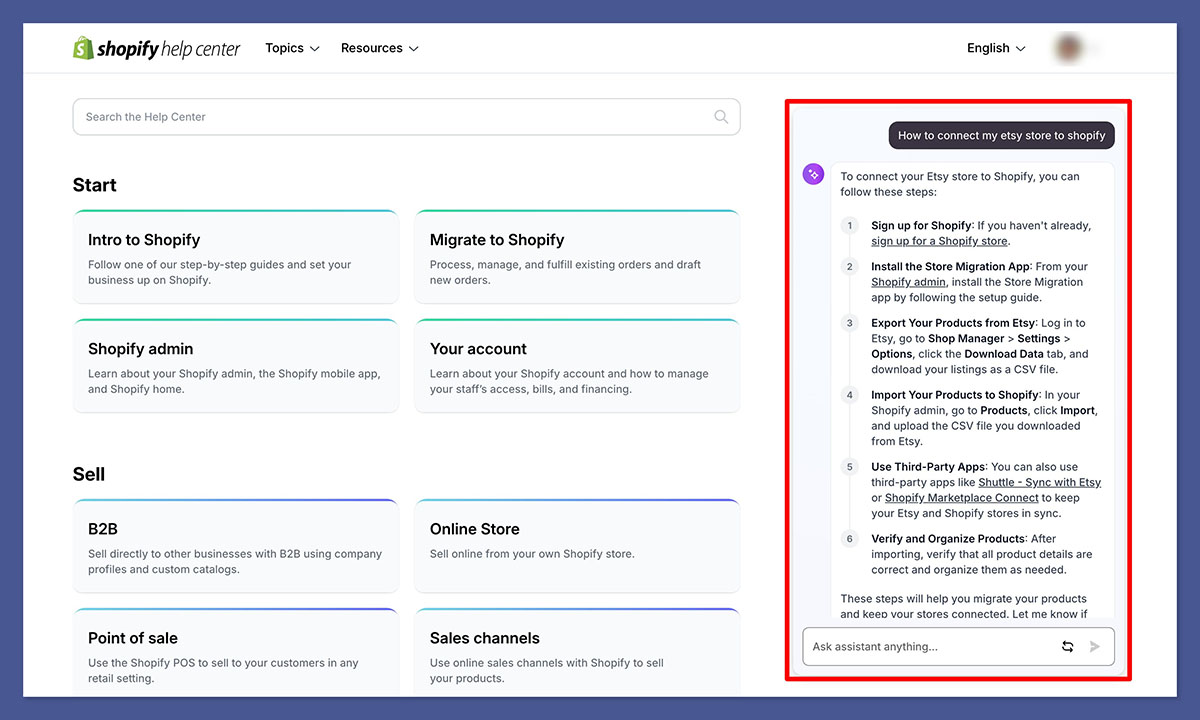
Plus, you get that handy Shopify Sidekick tool, mentioned above.
If you can’t get the answer, you need from AI, you’ll be able to request support from a human technician, and most respond within a matter of seconds.
However, I was able to find most of the guidance I needed within Shopify’s comprehensive self-help resources. There are countless informative articles, videos, guides, and even “courses” to explore.
Unfortunately, in comparison, Etsy’s support resources are pretty basic. The help center is decent enough – and there are some great guides out there.
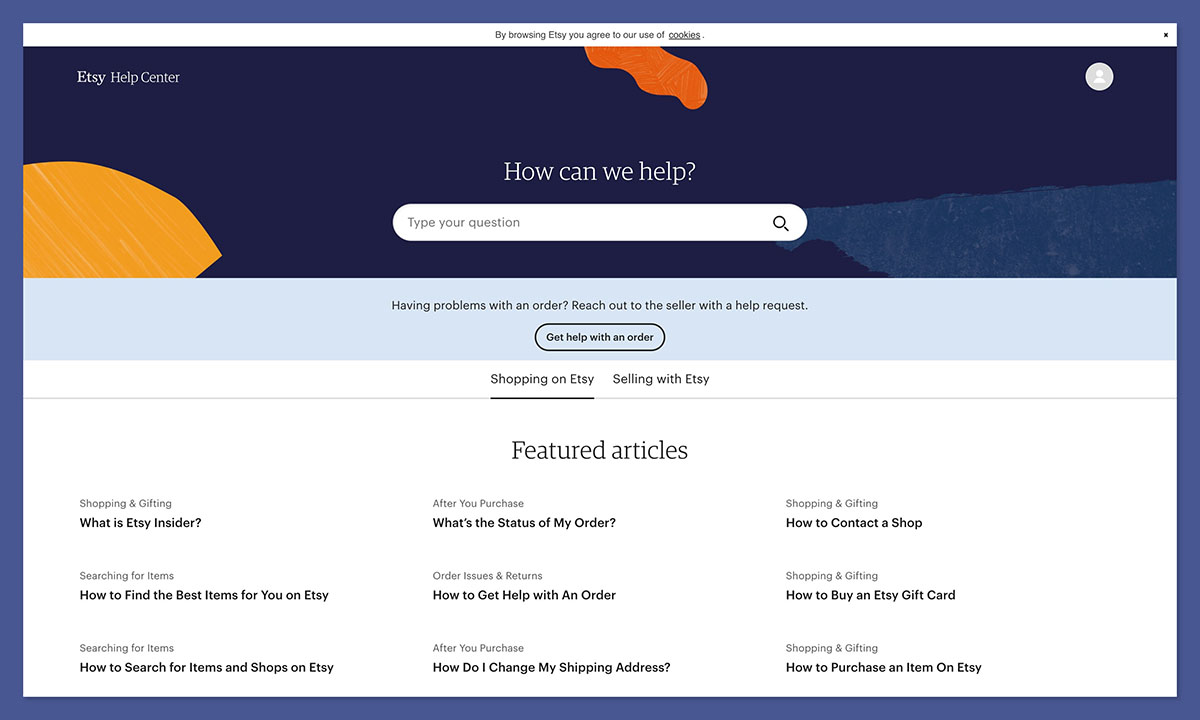
Plus, you can find other Etsy sellers to help you on channels like Reddit and Facebook. Still, if you need direct human support, it’s really hard to find any way to get in touch beyond submitting a request from the help center.
Why Sellers are Abandoning Etsy
Since Shopify has beaten Etsy in virtually every category of this comparison, you may not be surprised to learn that a lot of sellers have been giving up on the marketplace lately.
However, it’s not just a lack of functionality that makes Etsy problematic for sellers.
I checked out some forums like Reddit, and found that a lot of people are complaining about the rise of “AI” tools on the platform that are allowing merchants to create hundreds of listings instantly – making it almost impossible for new sellers to stand out in the market.
Etsy has always been a competitive place for beginners, but now it’s almost impossible to reach your audience.
On top of that, people complain that Etsy isn’t particularly supportive of its sellers (they’re focused more on buyers). If you have a problem with a customer, most of the time Etsy will rule in their favor.
Even if you do manage to build a decent store with Etsy, there’s a good chance someone else will come along and “copycat” your designs – then sell them for a lower price.
Shopify vs Etsy: Which Should You Choose?
It’s probably clear from this review that I think Shopify is a much better solution than Etsy. However, that doesn’t mean Etsy doesn’t have value.
It’s still a good place to connect with potential customers – and it’s still cheap and easy to use. However, I’d suggest looking at Etsy as a launchpad.
If you want to sell simple craft goods as a “side gig”, create a storefront with Etsy, but consider using Shopify too.
As your business grows, Shopify will give you a lot more room to scale, and having your own ecommerce platform will allow you to sidestep the growing problems with the Etsy platform.




